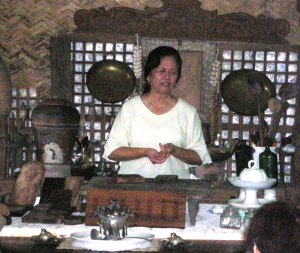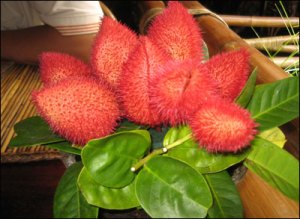Last weekend I joined a convoy of cars and a small coach bound for Pampanga. It was my first trip further north than Quezon City, and I was wide-eyed with curiosity like Alice down the rabbit hole. As we left Manila behind us, billboards loomed over the motorway. The landscape was open and unvaryingly flat. Corrugated iron farm buildings squatted along the roadside, liberally coated in rust, Palm trees pepper the rice fields, and telephone towers punctuated the horizon like exclamation marks. Occasionally we passed a solitary carabao. (More of them later, but please note the carabao is a water buffalo not a Canadian moose, pronounced carabow not cariboo).
The infamous Mt. Pinatubo lowers from the outskirts of Pampanga. As such, the province is often threatened with the destructive force of volcanic mud slides, which have even been known to breach the FVR Megadike designed to contain them. On the other hand, the benefits of that same volcanic mud are apparent in the lush river cane and rice fields, and perhaps as a result of such plenty, Pampanga is also known as the culinary capital of the Philippines.
Eventually we arrived at the home of ‘culinary luminary’ Lillian Borromeo,  just in time for merienda. Staff greeted us with a glass of chilled pandan tea in the delightful open air kitchen at the rear of the property. The sala was choc-a-block with culinary artifacts. There were flat bottomed copper pots hanging on the walls, good for cooking paella or mango jam; curvaceous old palayoks (clay cooking pots) were piled on a well-worn table top; a giant bamboo whisk shaped like a squash racquet – for making giant meringues perhaps? And finally, a selection of intricately hand-carved 17th century wooden molds for impressing on the San Nicolas religious cookies for which Lillian is renowned. The walls and ceilings were made from woven rattan, like a Fijian mat we once owned, reminding me that despite the cultural influences of both Spain and China, the Philippines are Pacific islands at heart.
just in time for merienda. Staff greeted us with a glass of chilled pandan tea in the delightful open air kitchen at the rear of the property. The sala was choc-a-block with culinary artifacts. There were flat bottomed copper pots hanging on the walls, good for cooking paella or mango jam; curvaceous old palayoks (clay cooking pots) were piled on a well-worn table top; a giant bamboo whisk shaped like a squash racquet – for making giant meringues perhaps? And finally, a selection of intricately hand-carved 17th century wooden molds for impressing on the San Nicolas religious cookies for which Lillian is renowned. The walls and ceilings were made from woven rattan, like a Fijian mat we once owned, reminding me that despite the cultural influences of both Spain and China, the Philippines are Pacific islands at heart.
As we explored the hoard of kitchen knick-knacks and paraphernalia, Lillian quietly took her place behind the kitchen bench and, speaking in a soft, almost whispery voice, shared the local fables about San Nicolas before demonstrating how to make the cookies. As she prepared the dough, she explained how the recipe came about. During Spanish times, the local churches were apparently built with stones cemented together with egg whites. Overwhelmed by a subsequent surplus of yolks, someone invented a recipe for these shortbread-style biscuits. The results are a little dry and surprisingly lacking in sugar for a Filipino cookie, but they are moreish, and apparently perfect for dipping into hot chocolate.
Lillian proved her point by concocting a steaming bowl of hot chocolate in a copper pot over an open fire. The cacao beans had been ground together with peanuts using an ancient chocolate grinding stone in the back garden, similar to those used for grinding grain, and it provided enough heat during grinding to melt the chocolate. It was a long, slow process for those manning the wheel, as it can take an hour to grind a small take-away tub of liquid chocolate. This was then stirred with creamy caribao milk over the heat, till thick and foamy, it was transferred into a copper jug and whisked with a traditional wooden molinet or molinillo. The Spanish replaced the traditional chillies with sugar to make the sweeter chocolate drink which we all enjoy today. Lillian suggested a dash of condensed milk as well, and then showed us an antique copper pojia (pronounced po-hi-ya), a ladle-shaped saucepan specially designed to make hot chocolate for two.
It was a long, slow process for those manning the wheel, as it can take an hour to grind a small take-away tub of liquid chocolate. This was then stirred with creamy caribao milk over the heat, till thick and foamy, it was transferred into a copper jug and whisked with a traditional wooden molinet or molinillo. The Spanish replaced the traditional chillies with sugar to make the sweeter chocolate drink which we all enjoy today. Lillian suggested a dash of condensed milk as well, and then showed us an antique copper pojia (pronounced po-hi-ya), a ladle-shaped saucepan specially designed to make hot chocolate for two.
For lunch we moved on to a 17th century Spanish-Filipino Heritage house, which was built in 1824 by the city founder, Don Ángel Pantaleón de Miranda. It is the oldest house in Angeles, and walking through the door is like stepping back in time. The rooms are cluttered with antique furniture and clocks. The ceilings are molded and highly decorative. One bedroom had an unusual cone-shaped ceiling and tiny square window panes made from the translucent window pane shell Placuna placenta that was traditionally used in windows in Asia. A richly robed saint and the Angel Gabriel stand, full-size, in glass cases, watching over the dining tables. Apparently every 17th century Spanish-Filipino house had its own saint that would be carried through the streets in the Saints Day procession.
Eventually we joined local celebrity Chef Sau and his nephew – the most recent in a family line-up of chefs spanning four generations – in the kitchen for a cooking demonstration of chicken tamales wrapped in banana leaves. Steamed and unwrapped it looked like a Spanish omelette. The texture was similar too. But the dark orange acheute oil provided a whole new taste for me.  Acheute is a small red fruit with a Mohawk, not unlike a rambutan. It originally came from South America, and when the tiny red seeds are steeped in oil it makes an interesting smoky taste.
Acheute is a small red fruit with a Mohawk, not unlike a rambutan. It originally came from South America, and when the tiny red seeds are steeped in oil it makes an interesting smoky taste.
Then it was time to sit down to a seven course Kapampangan banquet. Renowned ‘organic’ celebrity chef Sau del Rosario, has impressive international credentials: Raffles in Singapore, Luna in Shanghai, the EDSA Shangri La. He has also made an extensive study tour of France and French cuisine. Closer to home, the Ayala Museum Café benefitted from Chef Sau’s imaginative take on Asian fusion. Today, it was time to set up camp in his home town and introduce us to some local specialties.
First up, firm, steamed prawns served with a salad of local ferns and sprinkled with red and purple geranium petals for colour. This was sprinkled with a light coconut vinegar dressing. I had never tried coconut vinegar before, but I loved it. It gently spiced up an otherwise rather bland dish.
The second dish was wonderfully crispy catfish wrapped in a tangy mustard leaf and served with buro, a paste made from fermented rice and shrimps, indigenous to Pampanga. I am learning to enjoy these Filipino fish pastes in the right context. They can enhance a meal with a satisfying dash of saltiness.
A pork rib sinigang came next, served in a tea cup and saucer. Chef Sao then poured a thick pork broth over the ribs, guava, okra and beans. I found that the guava gave the rich pork broth a satisfying dash of sharpness.
The penultimate savoury dish was a beautifully cooked piece of Bangus or milkfish stuffed with pork and served with pork gravy (Filipino Surf & Turf?) which delighted the palate (mine anyway!). To complete the main meal, we were given a serving of Beef Morcon. Like a roulade, this rolled beef was very prettily presented with a tomato sauce and a pingpong ball of rice.
And still there was dessert. I finally got to taste the Philippines famous Leche flan (think crème caramel) which was accompanied by a sweet ube (yam) paste. Although ube can be a rather off-putting colour (ube means violet in Tagalog, and so it is!) it proved a perfect accompaniment to the light, creamy flan. This was followed by Tibok tibok, a traditional Kapampangan dessert made from carabao milk and rice. The name means ‘heart beat’ due to the sound of the thick milk and rice mixture as it boils – can’t you hear it? This was Chef’s Sau’s version of one we had watched Lillian make for us: sticky rice and molasses sprinkled with toasted coconut. “Delish-oos”. And I couldn’t possibly choose a favourite, I loved them both. Finally we were presented with a small woven purse containing a selection of local lollies – pastillas de leche – made from the ubiquitous carabao milk, with their traditional pabalat (coloured paper) wrapper. Unfortunately I had not an ounce more room for, and had to take them home to my children!
Our final stop was a tiny shop house on the outskirts of Santa Ana. Our guides had told us that this place serves the best halo-halo ever. Local food writer and chef, Claude Tayag says so too! So despite the late hour (it was already after 5pm and we were supposed to be back in Manila by 5.30… well that’s not going to happen!), we made a detour and, like musical chairs, we squeezed our 25 over-fed bodies onto a dozen plastic stools to await the grand finale. For a true devotee of halo-halo, it may have been worth wait. I was too tired and too full to care. It was certainly refreshing – shaved ice with a dash of carabao milk, and none of the usual multi-coloured palaver you will find at Milky Way or other such cafes competing for the most glorious version of halo halo. Instead there was a simplicity that was appealing at the end of such an over-indulgent day. But only if you like your dessert with sweet corn and mashed white kidney beans. However, the response from the rest of the group was positive, and if Mr. Tayag recommends it, who am I to argue..?
Tour Flair: Signature Philippine Tours. For more information, contactT eresa, Lory-Vi or Mindy by email: tourflair@gmail.com

After reading your blog post I browsed your website a bit and noticed you aren’t ranking nearly as well in Google as you could be. I possess a handful of blogs myself and I think you should take a look here: http://dominateseowithwordpress.com You’ll find it’s a very nice tool that can bring you a lot more visitors. Keep up the quality posts
Thanks Carlota Maria! Your tip much appreciated.
Hi there! I could have sworn I’ve been to your blog
before but after browsing through some of the
articles I realized it’s new to me. Nonetheless, I’m certainly pleased I stumbled upon it and I’ll be book-marking it and
checking back frequently!
I’m not that much of a internet reader to be honest but your blogs really nice, keep it up!
I’ll go ahead and bookmark your website to come back down the
road. All the best
Thanks!
I always spent my half an hour to read this web site’s content daily along with a cup of coffee.